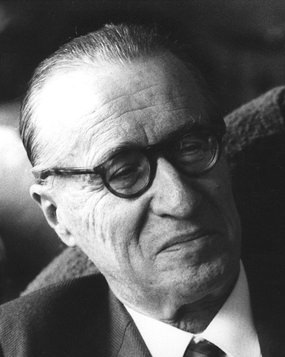Go to almost any orchestral concert and you’ll find that there’s probably a concerto for something-or-other on the programme. Why are concertos so popular? Perhaps it’s because by their nature, concertos tend to be show-pieces. Perhaps it’s because the spectacle of a single musician pitted against a full orchestra has theatrical appeal.
Professor Octavio Roca of the University of Miami wrote, “There’s always drama in a concerto. It’s a musical form based on contrasts, a battleground for the most passionate musical ideas and a showcase for heroic musical gestures. The concerto is also, perhaps even more than the symphony or string quartet, the most accessible… for the newcomer to classical music.”
 Composer Jean Françaix.
Composer Jean Françaix.
The concerto in one form or another has been around for about three hundred years. The concept of the concerto – that of contrasting one source of sound against another – had existed for even longer but it was developed in Venice during the sixteenth century. As time passed, the concerto evolved into both the solo concerto and the so-called concerto grosso in which a group of instrumentalists were contrasted with a larger ensemble.
Vivaldi wrote hundreds of concertos and standardised it into the conventional three movement form. During the eighteenth century it went through a process of refinement but in the nineteenth century the concerto reached a pinnacle of popularity. This was partly because many of them were commissioned by top soloists of the day who expected composers to write something which would demonstrate the soloist’s brilliant technical skills. They wanted musical fireworks – and usually got them.
A double concerto is nearly always for two instruments and orchestra and its history dates back to the baroque. Many double concertos have been written especially for two violins, or violin and cello. Ask any classical musician to name double concertos and you can bet they’ll come up with either those of Bach or Brahms.
Johann Sebastian Bach (1685-1750): Double Violin Concerto in D minor BWV 1043. Natalia Stêposz, Zuzanna Bolon (vlns), Cracow Young Philharmonic cond. Tomasz Chmiel (Duration 17:31; Video: 1080p HD)
Known in the music business simply as “The Bach Double”, this is probably one of the composer’s most famous works and dates from sometime between 1717 and 1723 when he was working for the musically enlightened Prince Leopold of Anhalt-Cothen. Unlike the violin concertos of Vivaldi, Bach’s violin concertos are not intended as show-pieces even though they’re technically demanding.
The work is cast in three movements and relies largely on the soloists exchanging themes and musical phrases, weaving them into complex counterpoint. The second movement is one of Bach’s most sublime and eloquent musical creations. There are plenty of recordings of this work by big-name international musicians but I rather liked this youthful performance because although it’s not flawless, it contains some attractive and thoughtful playing.
Jean Françaix (1912-1997): Double Concerto for Flute, Clarinet and Orchestra. Jean-François Doumerc (fl), Radovan Cavallin (clt) Orquesta Filarmónica de Gran Canaria cond. Christoph Campestrini (Duration: 23:04; Video: 720p HD)
There’s something terribly French about the music of Jean Françaix. It’s as French as baguettes, the Citroën 2CV and Édith Piaf. Françaix was a prolific composer known for his colourful and lively musical style. He was a gifted child born into an intensely musical family and started composing at the age of six in a style influenced by Ravel. Although Françaix became an accomplished concert pianist he never stopped composing, barely finishing one piece before starting another.
This double concerto dates from 1991, but in parts sounds as though it comes from seventy years earlier. It’s a delightful work and unusually for a concerto, comes in four movements. There’s a particularly boisterous finale reminiscent of la gaîté Parisienne of the 1920s.
André Previn (b. 1929): Double Concerto for Violin, Cello and Orchestra. Jaime Laredo (vln), Sharon Robinson (vlc), Detroit Symphony Orchestra con. Leonard Slatkin (Duration 25:04; Video: 720p HD)
You might associate Previn’s name either with his early recordings as a jazz pianist or perhaps with his later work as a conductor, because he was principal conductor for the London Symphony Orchestra for over ten years before moving to the Los Angeles Philharmonic. Previn is also a prolific composer with a couple of dozen film scores to his credit together with an enormous amount of orchestral music, chamber music, songs and two operas.
Written in 2007, this work was commissioned by a consortium of eight orchestras and given its first performance by the Boston Symphony with the composer conducting. The music is rhythmic, tuneful, approachable, sophisticated, well-written and not surprisingly, brilliantly orchestrated. Each movement begins with a short duet by the two soloists. The lyrical and retrospective slow movement, in which the opening and closing duets are particularly compelling, seems to be at the heart of this splendid concerto.




